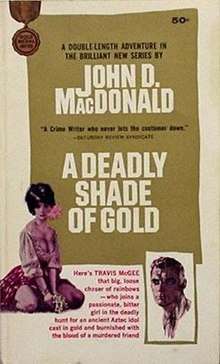A Deadly Shade of Gold
A Deadly Shade of Gold (1965) is the fifth novel in the Travis McGee series by John D. MacDonald. The plot revolves around a solid gold Aztec statuette, and takes McGee from his home of Florida to Mexico and Los Angeles. The cover bills this novel as a "double-length adventure" and is about twice as many pages as the previous Travis McGee novels.
 First edition cover | |
| Author | John D. MacDonald |
|---|---|
| Country | United States |
| Language | English |
| Series | Travis McGee |
| Genre | Crime |
| Published | February 4, 1965[1] |
| Publisher | Fawcett Publications |
| Media type | Print (paperback) |
| ISBN | 978-0-449-22442-7 |
| OCLC | 35854700 |
| Preceded by | The Quick Red Fox |
| Followed by | Bright Orange for the Shroud |
Plot
The back of the first edition paperback states, "A long-ago face from a faraway past - Sam Taggart dropped in from nowhere on the girl he's left behind - and on his old buddy Travis McGee. At one o'clock that night McGee opened the door to Taggart's cheap motel unit to find his friend's throat neatly cut from eat to ear and his boy lying in a lake of blood smelling like freshly sheared copper.
McGee was left to inherit the legacy: Taggart's vengeance-driven woman and an ancient Aztec golden idol. The girl would plunge McGee on a wild and perilous trek which led from the Lauderdale beaches to the seething corruption of American expatriates in a distinct Mexican town., to the lush highlife of the California jet set.
Themes
This is the first book in which the character simply known as "Meyer" plays a substantial part. John MacDonald introduces him in the first chapter: “He looks like a diarama (sic) of Early Man in the Museum. of Natural History. He has almost as much pelt as an Adirondack black bear. But he can stroll grinning down a beach and acquire a tagalong flock of lovelies the way an ice cream truck ropes children. He calls them all Junior. It saves confusion. He is never ever seen with one at a time. He lives alone aboard a squatty little cruiser and is, by trade, an Economist. He predicts trends. He acquired a little money the hard way, and he keeps moving it around from this to that, and it keeps growing nicely, and he does learned articles for incomprehensible journals."
References
- Merril, Hugh (2000). The Red Hot Typewriter: The Life and Times of John D. MacDonald. Thomas Dunne Books/St. Martin's Minotaur. ISBN 978-0-312-20905-6.
- Geherin, David (1982). John D. MacDonald. F. Ungar Pub. Co. ISBN 978-0-8044-2232-1.
- "Books Today". The New York Times: 28. February 4, 1965.